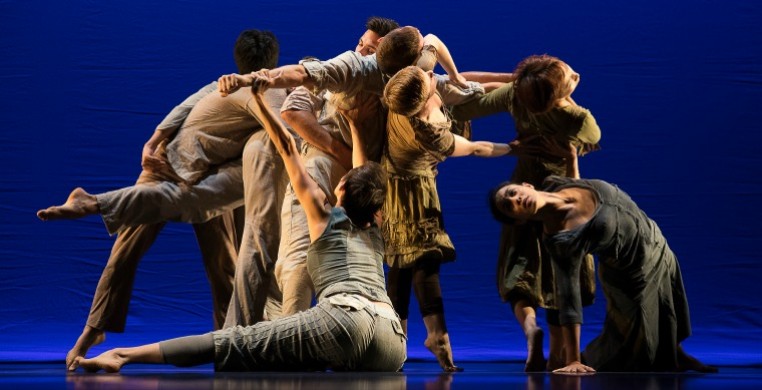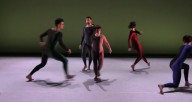As a kid, Doug Varone loved MGM musicals. He was a young tapper, and he idolized Gene Kelly and Fred Astaire. What most intrigued Varone about them was “how they could move from being an incredible dancer to just a person,” moving in the every day ways that real people move. The humanity of movement has fueled his creative engine ever since in a continuous quest to blur the lines that separate art and life. Doug Varone
Doug Varone
His New York-based company, Doug Varone and Dancers, celebrating its 31st season, returns to the Dance Center of Columbia College Chicago for the first time in 17 years this Thursday, Friday, and Saturday (February 8-10) at 7:30 PM. The program embodies that aesthetic with material that explores both abstract movement and theme-based concepts in a lush, lyrical style that is emotionally compelling, visually provocative, and immediately engaging to watch.
Varone is a multi-faceted choreographer whose career has produced a rich body of work that encompasses contemporary dance, opera, theater, film, and fashion.
In 1991, when Doug Varone and Dancers made their first appearance at the Dance Center, the performance venue was still in Uptown. By the time they returned in 2001, the Dance Center had just moved into its new space, poised to become Chicago’s premiere presenter of contemporary dance, right on the heels of 9/11. “It felt as if everything had been lost,” he said in a recent phone interview with SeeChicagoDance. That year, they performed “Ballet Méchanique,” which, while it was created earlier that summer, evoked a sense of doom and destruction for Varone, with a cacophonous score by George Anthiel that somehow spoke to the mood of the time. For their performances this coming week, Varone wanted to bring a body of work that hadn’t been seen in Chicago.  Doug Varone and Dancers
Doug Varone and Dancers
“Nocturne(s)” (1987 and 2017) opens the program with Varone performing two solos set to piano music by Chopin, and created 30 years apart. In 1987, he began exploring a limited vocabulary within the structure and style of the music. His objective was to discover what is inherent in his body, in essence, the truth of the way he moved. Jacob’s Pillow Dance Festival commissioned the second solo in 2017 as a companion to the first in celebration of the company’s 30th anniversary. “It’s a beautiful exploration of an artist at the beginning, and now, in a more nuanced approach.”
“folded” (a duet) and “shelter” (a trio) are excerpted from the five-episode suite "in the shelter of the fold" (2016) with “folded” set to music by Julia Wolfe and “shelter” to music by David Lang. Taking off from the acknowledgment that we all have faith in something, it questions the concept of faith and belief from a non-religious point of view. “These dances are jumping off points for how we deal with our faith, always questioning,” Varone said. “The duet has a visceral, hard-edged movement vocabulary, constantly spilling out in a battle between two ideologies.”
“Boats Leaving” (2006), and “Lux” (2006) are revivals of company classics that Varone characterizes as “kindred spirits created within a year of each other that came out of the same era for different reasons.” Complimenting and contrasting each other, “Boats Leaving” deals with loss, while “Lux” is all about the need to regenerate.
Varone traces his path to becoming a choreographer all the way back to his earliest memories as a toddler. “I was a choreographer from the very first time I started playing and moving things, building little scenarios. Moving bodies through space in different configurations has always intrigued me.” Hollis Bartlett and Alex Springer in Varone's "Carrugi"
Hollis Bartlett and Alex Springer in Varone's "Carrugi"
He was strongly influenced by his teachers at SUNY Purchase, where he studied with Kazuko Hirabayashi, among others. José Limón was a choreographer who had a major impact on Varone. He was especially influenced by the humanity behind Limón’s work and his representation of flawed men. “His movement felt honest in my body—the fall and recovery, the softness and lyricism.” Varone danced with the Limón company for a year and also performed with Lar Lubovitch before starting his own company. "I have always embraced the sensibility of how we move as dancers and as human beings," he said, "blending the two--the use of weight, how we walk and swing our arms," never seeing the line between the dancer and the person. In each of his works, Varone seeks to “find something that needs to be said, and finding what’s universal so others can see themselves in it.”
When asked what he wants his audiences to take away from these performances, Varone responds, “If they are thinking about the work when they are walking out the door, and if they remember it, if they are feeling something, that excites me.”
For details and tickets, visit the event page: http://seechicagodance.com/event/doug-varone-and-dancers


